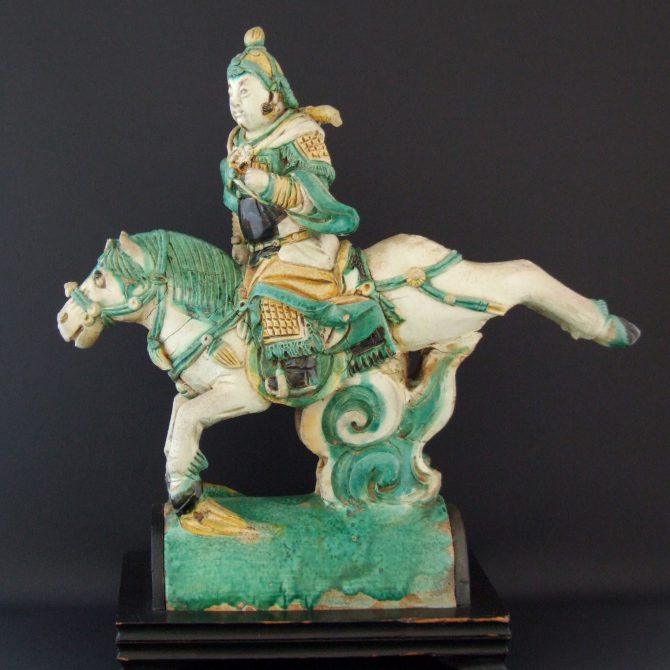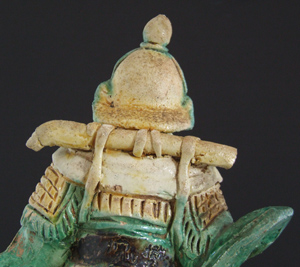
MING DYNASTY c.1500 – 1640 Ming Tile-works Pottery
A Fine Ming Dynasty Tile-Works Liuli Wa Roof-Tile Depicting Han Xin, Probably Shanxi Province, Late Ming c.1500-1640. The Glaze is Thinly Applied to the Figure and the Colours are of Muted Hues. There is a Lot of Carving and Applied Decoration Added to the Basic Moulded Form. The Ridge Tile Inscribed Under the Glaze with the Name `Wong Shong Jian`.
- Condition
- Good condition, minor losses.
- Size
- N/A
- Provenance
- Captain James Grey Stuart, 1st Viscount Stuart of Findhorn CH, MVO, MC and Bar, PC. Secretary of State for Scotland. Lived 1897 – 1971 Robert McPherson Antiques, probably early 1990`s. An English Private Collection. This Ming roof-tile was one of a pair belonging to Captain James Grey Stuart. Both have the same fitted stand, the other figure has an old paper label on the base of the stand sating it belonged Stuart Earl of Moray Viscount of Findhorn. The Label states that there were two such figures. We sold this one many years before we had the figure with the label. Captain James Grey Stuart, 1st Viscount Stuart of Findhorn CH, MVO, MC and Bar, PC (9 February 1897 – 20 February 1971), styled The Honourable James Stuart between 1909 and 1957, was a Scottish Unionist politician. He was joint-Parliamentary Secretary to the Treasury in Winston Churchill`s war-time coalition government and later served as Secretary of State for Scotland under Churchill and then Sir Anthony Eden from 1951 to 1957. The latter year he was elevated to the peerage as Viscount Stuart of Findhorn. Stuart sat as Member of Parliament (MP) for Moray and Nairn from 1923 to 1959. He served as a Lord of the Treasury from 1935 to 1941 under successively Ramsay Macdonald, Stanley Baldwin, Neville Chamberlain and Winston Churchill and was sworn of the Privy Council in 1939. In 1941 Churchill promoted him to joint Parliamentary Secretary to the Treasury (Government Chief Whip), which he remained until 1945. He continued as Conservative Chief Whip until 1948. In 1950 he became Chairman of the Scottish Unionist Party, a post he held until 1962. When the Conservatives returned to power under Churchill in 1951, Stuart was made Secretary of State for Scotland, with a seat in the cabinet. He continued in this post until 1957, the last two years under the premiership of Sir Anthony Eden. He was appointed a Companion of Honour in 1957. On 20 November 1959 he was elevated to the peerage as Viscount Stuart of Findhorn, of Findhorn in the County of Moray. Information from http://en.wikipedia.org/wiki/James_Stuart,_1st_Viscount_Stuart_of_Findhorn
- Stock number
- 23626
- References
- For the pair to this Ming roof-tile which bares the inscription "Ma Chiu" see `Sold Items` number 19065. For related Ming roof-tiles of celestial warriors see : Catalogue of Late Yuan and Ming Ceramics in the British Museum.(Jessica Harrison-Hall.The British Museum Press, 2001. ISBN 0-7141-1488-X.) pages 534, item 18:30 and page 535, item 18:31.
Information
Han Xin :
Han Xin lived a childhood in destitution as his father died early. He was despised by those around him as he often relied on others for his meals. He had a keen interest in military strategy and spent his time studying military treatises and practising sword techniques. Once, when he was suffering from hunger, he met a woman who provided him with food. He promised to repay her for her kindness after he had made great achievements in life, but was scorned by her. On another occasion, a hooligan saw Han Xin carrying a sword and challenged him to either kill him or crawl through between his legs. Han Xin knew that he was at a disadvantage because his opponent was much stronger and bigger than him, hence instead of responding to the taunts, he meekly crawled through between the hooligan`s legs and was laughed at. Several years later, after becoming the King of Chu, Han Xin returned to his home town and found the woman who fed him and rewarded her with 1,000 taels of gold. Han Xin also found the hooligan and instead of taking revenge, he appointed the hooligan as a zhongwei ; equivalent to a present-day lieutenant). He said, "This man is a hero. Do you think I could not have killed him when he humiliated me? I would not become famous even if I killed him then. Hence, I endured the humiliation to preserve my life for making great achievements in future." Han Xin is best remembered as a brilliant military leader for the strategies and tactics he employed in warfare, some of which became the origins of certain Chinese idioms. In recognition of Han Xin`s contributions, Liu Bang conferred the titles of "King of Qi" on him in 203 BC and "King of Chu" in the following year. However, Liu Bang feared Han Xin`s growing influence and gradually reduced his authority, demoting him to "Marquis of Huaiyin" in late 202 BC. In 196 BC, Han Xin was accused of participating in a rebellion and lured into a trap and executed on Empress Lü Zhi`s orders. For more information go to http://en.wikipedia.org/wiki/Han_Xin
Ming Pottery Roof Tiles / Liuli Wa :
According to traditional Chinese belief, roofs are platforms of communication between the words of the living and spirit realms. Consequently they were decorated to ward off evil and to act as a magnet for blessings and good fortune. Marco Polo was struck by the visual effect of these brightly coloured tiles, remarking while describing Khubilai Khan`s palace at Dadu (modern day Beijing) The roof is all ablaze with scarlet and green and blue and yellow and all the colours that are, so brilliant varnished that it glitters like crystal and the sparkle of it can be seen from far away. The Chinese had made ceramic tiles from early times but it was the Ming dynasty that saw the largest period of production, much of this was based in Shanxi Province at small family run kilns that passed down from generation to generation. Glazed tile-work is known in China as Liuli Wa, literally `roof-tile of glass`, a term dating back to the Tang Dynasty (618-906) although Tang tiles are now very rare. The soft earthenware used to make Ming tiles varies but often is uneven in its constitution with lots of grog. The tiles were mould made with a large amount of hand working, giving a completely hand-made look with lots of sharp detail and undercutting. They were lead glaze and low fired which means the glaze often runs. There were two basic colour schemes used Sancai (greens,yellows and browns) and the darker palette of Fahau (turquoise, blue and purple). The dating of Chinese glazed tiles, which were made over a long period of time with little change, is difficult. Knowing when the building they came from was build doesn`t help as tiles, exposed to the elements, needed replacing from time to time and so a building might contain tiles made over several centuries. However an approximate chronology can be understood, and with the study tile construction replacements can be identified as being different to the genuine Ming examples.








